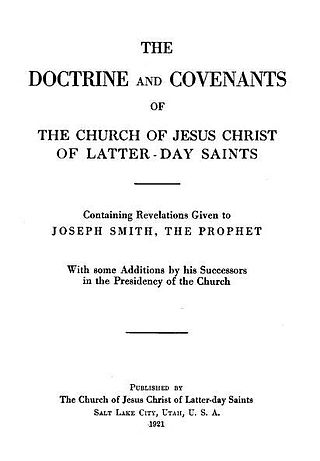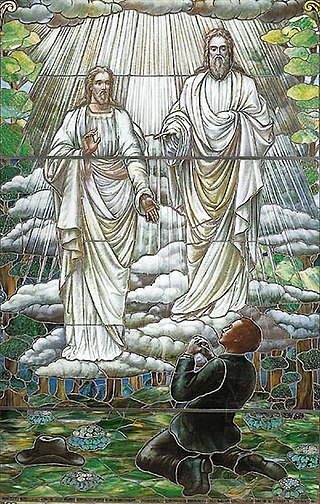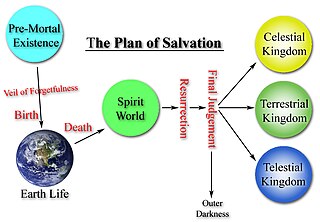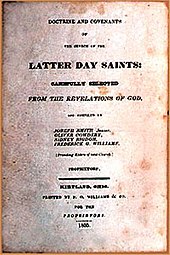
The Standard Works of the Church of Jesus Christ of Latter-day Saints are the four books that currently constitute its open scriptural canon. The four books of the standard works are:

The Doctrine and Covenants is a part of the open scriptural canon of several denominations of the Latter Day Saint movement. Originally published in 1835 as Doctrine and Covenants of the Church of the Latter Day Saints: Carefully Selected from the Revelations of God, editions of the book continue to be printed mainly by the Church of Jesus Christ of Latter-day Saints and the Community of Christ.

Mormonism is the theology and religious tradition of the Latter Day Saint movement of Restorationist Christianity started by Joseph Smith in Western New York in the 1820s and 1830s. As a label, Mormonism has been applied to various aspects of the Latter Day Saint movement, although there has been a recent push from the Church of Jesus Christ of Latter-day Saints to distance themselves from this label. A historian, Sydney E. Ahlstrom, wrote in 1982 that, depending on the context, the term Mormonism could refer to “a sect, a mystery cult, a new religion, a church, a people, a nation, or an American subculture; indeed, at different times and places it is all of these."
The Adam–God doctrine was a theological idea taught in mid-19th century Mormonism by Brigham Young, a president of the Church of Jesus Christ of Latter-day Saints. Although the doctrine is rejected by the LDS Church today, it is still an accepted part of the modern theology of some Mormon fundamentalists.
In Mormonism, the restoration refers to a return of the authentic priesthood power, spiritual gifts, ordinances, living prophets and revelation of the primitive Church of Christ after a long period of apostasy. While in some contexts the term may also refer to the early history of Mormonism, in other contexts the term is used in a way to include the time that has elapsed from the church's earliest beginnings until the present day. Especially in the Church of Jesus Christ of Latter-day Saints "the restoration" is often used also as a term to encompass the corpus of religious messages from its general leaders down to the present.

The First Vision refers to a theophany which Latter Day Saints believe Joseph Smith experienced in the early 1820s, in a wooded area in Manchester, New York, called the Sacred Grove. Smith described it as a vision in which he received instruction from God the Father and Jesus Christ.
In the Latter Day Saint movement, priesthood is the power and authority of God given to man, including the authority to perform ordinances and to act as a leader in the church. A group of priesthood holders is referred to as a quorum.

The Church of Jesus Christ is an international Christian religious denomination headquartered in Monongahela, Pennsylvania, United States. Organized at Green Oak, Pennsylvania, U.S.A. in the year 1862. The church is a Christian Restorationist church and accepts the Book of Mormon as scripture. The church considers itself the gospel restored, or the original church and good news as established by Jesus Christ in the New Testament, restored upon the earth. It also claims to be the spiritual successor to the Church of Christ, organized by Joseph Smith on April 6, 1830. The church sees Sidney Rigdon as Smith's rightful successor following the assassination of Smith because Rigdon was Smith's first counselor in the First Presidency. The church is not officially affiliated with any other church, organization or denomination.

The Latter Day Saint movement is the collection of independent church groups that trace their origins to a Christian Restorationist movement founded by Joseph Smith in the late 1820s.
In orthodox Mormonism, the term God generally refers to the biblical God the Father, whom Latter Day Saints also refer to as Elohim or Heavenly Father, and the term Godhead refers to a council of three distinct divine persons consisting of God the Father, Jesus Christ, and the Holy Ghost. However, in Latter Day Saint theology the term God may also refer to, in some contexts, the Godhead as a whole or to each member individually. Latter Day Saints believe that the Father, Son and Holy Ghost are three distinct beings, and that the Father and Jesus have perfected, glorified, physical bodies, while the Holy Ghost is a spirit without a physical body. Latter Day Saints also believe that there are other gods and goddesses outside the Godhead, such as a Heavenly Mother—who is the wife of God the Father—and that faithful Latter-day Saints may attain godhood in the afterlife. The term Heavenly Parents is used to refer collectively to the divine partnership of Heavenly Father and a Heavenly Mother. Joseph Smith taught that God was once a man on another planet before being exalted to Godhood.
Within the Latter Day Saint movement, the "Articles of Faith" is a statement of beliefs composed by Joseph Smith as part of an 1842 letter sent to "Long" John Wentworth, editor of the Chicago Democrat, and first published in the Latter Day Saint newspaper Times and Seasons. It is a concise listing of thirteen fundamental doctrines of Mormonism. Most Latter Day Saint denominations view the articles as an authoritative statement of basic theology. Some denominations, such as the Church of Jesus Christ of Latter-day Saints, have adopted the articles as scripture. For some sects, the Articles of Faith are known collectively as "An Epitome of Faith and Doctrine".
Joseph Fielding McConkie was a professor of Ancient Scripture at Brigham Young University (BYU) and an author or co-author of over 25 books.

In the theology and cosmology of The Church of Jesus Christ of Latter-Day Saints, in heaven there are three degrees of glory which are the ultimate, eternal dwelling place for nearly all who lived on earth after they are resurrected from the spirit world.
A spirit body is, according to the Church of Jesus Christ of Latter-day Saints, the organization of a spiritual element, made into the spiritual form of man, which was made in the same likeness of God the Father. This likeness apparently gave rise to the phrase and meaning of, "like father like son," which means the son is in the likeness of the father, which provides meaning to the claim that humanity was made in the likeness of God. Generally, people in the world have commonly used the word "soul" to denote this spirit body.
The Church of Jesus Christ of Latter-day Saints teaches that Adam and Eve were the first man and the first woman to live on the earth and that their fall was an essential step in the plan of salvation. Adam in particular is a central figure in Mormon cosmology.

Community of Christ and the Church of Jesus Christ of Latter-day Saints are two denominations that share a common heritage in the Church of Christ founded by Joseph Smith on April 6, 1830. Since Smith's death in 1844, they have evolved separately in belief and practices. The LDS Church is headquartered in Salt Lake City, Utah, and claims more than 17 million members worldwide; Community of Christ is headquartered in Independence, Missouri, and reports a worldwide membership of approximately 250,000.

Mormon cosmology is the description of the history, evolution, and destiny of the physical and metaphysical universe according to Mormonism, which includes the doctrines taught by leaders and theologians of the Church of Jesus Christ of Latter-day Saints, Mormon fundamentalism, the Restoration Church of Jesus Christ, and other Brighamite denominations within the Latter Day Saint movement. Mormon cosmology draws from Biblical cosmology, but has many unique elements provided by movement founder Joseph Smith. These views are not generally shared by adherents of other Latter Day Saint movement denominations who do not self-identify as "Mormons", such as the Community of Christ.

The Church of Jesus Christ of Latter-day Saints focuses its doctrine and teaching on Jesus Christ; that he was the Son of God, born of Mary, lived a perfect life, performed miracles, bled from every pore in the Garden of Gethsemane, died on the cross, rose on the third day, appeared again to his disciples, and now resides, authoritatively, on the right hand side of God. In brief, some beliefs are in common with Catholics, Orthodox and Protestant traditions. However, teachings of the LDS Church differ significantly in other ways and encompass a broad set of doctrines, so that the above-mentioned denominations usually place the LDS Church outside the bounds of orthodox Christian teaching as summarized in the Nicene Creed.

Mormonism and Nicene Christianity have a complex theological, historical, and sociological relationship. Mormons express their doctrines using biblical terminology. They have similar views about the nature of Jesus Christ's atonement, bodily resurrection, and Second Coming as mainstream Christians. Nevertheless, most Mormons do not accept the doctrine of the Trinity as codified in the Nicene Creed of 325 and the Nicene-Constantinopolitan Creed of 381. Although Mormons consider the Protestant Bible to be holy scripture, they do not believe in biblical inerrancy. They have also adopted additional scriptures that they believe to have been divinely revealed to Joseph Smith, including the Book of Mormon, the Doctrine and Covenants, and the Pearl of Great Price. Mormons practice baptism and celebrate the sacrament of the Lord's Supper, but they also participate in other religious rituals. Mormons self-identify as Christians.
Exaltation is a belief in Mormonism that after death some people will reach the highest level of salvation in the celestial kingdom and eternally live in God's presence, continue as families, become gods, create worlds, and make spirit children over whom they will govern. In the largest Mormon denomination, the Church of Jesus Christ of Latter-day Saints, top leaders have taught God wants exaltation for all humankind and that humans are "gods in embryo". A verse in the LDS Church's canonized scripture states that those who are exalted will become gods, and a 1925 statement from the church's highest governing body said that "All men and women are in the similitude of the universal Father and Mother ... [and are] capable, by experience through ages and aeons, of evolving into a God."









